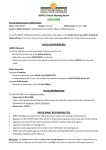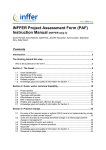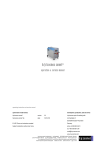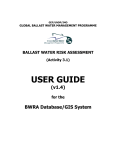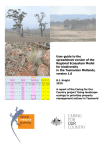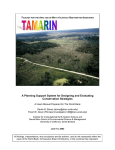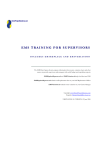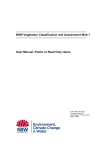Download INFFER Project Assessment Form User Manual
Transcript
Asset identification documentation sheet This sheet is for use in Day 1, Session 4. ‘Identifying assets’ of the INFFER training workshop. Background This sheet is a suggested recording system which will help with the documentation of information for the first step of the INFFER process: identifying assets that are potentially high priorities for investment. People often identify assets through group discussion and using a map to spatially represent their location. The sheet on the next page can be used as an aid to record the discussion/justification of why particular assets were chosen. This helps to capture some of the information required for the next steps of the INFFER process and helps keep decision making transparent. Instructions Fill out one sheet per asset. The sheet has a number of sections, as follows: Name of asset: This should be something that stakeholders and the community can associate with the asset. Location: Include a simple description of the location of the asset, include a town name as a reference point and if possible include the catchment/bioregion/landscape in which the asset sits. Description of asset: Include the type of asset (e.g. river reach, wetland, etc), the physical dimensions of the asset (e.g. 300ha, 10km river reach), and the tenure of the asset. Current condition of asset: Describe the current condition of the asset relative to its original condition and if possible indicate what is happening to the asset’s condition (e.g. declining, steady, improving). Community/social value: Describe what makes the asset significant to the community (e.g. amenity, philosophical, spiritual, or recreational value). Environmental value: Describe the values the asset generates for the environment (e.g. habitat for threatened species, intact vegetation). Economic value: Describe the economic values the asset has (e.g. consumptive uses such as water resource, or productive uses). Threats to asset: List all of the threats that are known to impact on the current or future condition of the asset. Other discussion notes: This section is to capture any additional information about the asset which may be useful for future reference. An example of a completed Asset Identification Sheet is provided below. INFFER Asset Documentation Sheet - Example Name of asset Tang Tang Swamp Location Description of asset Current condition of asset 6km west of Dingee in North Central Victoria Shallow freshwater marsh and immediate area in the wildlife reserve 126ha in size Marginal and declining due to dry times In the Bendigo/Myers subcatchment of the Loddon catchment Managed by Parks Victoria Last time the swamp was full of water was spring 2001 Community/social values Environmental values Economic values Indigenous cultural value with a number of oven mounds present Brolga breeding site Tourism JAMBA and CAMBA waterbirds recorded there Water quality Community value this site for recreation and aesthetics Rare and vulnerable flora species are also present Threats to the asset Other Discussion notes including key information sources Salinity Tang Tang swamp is part of a chain of wetlands extending north along the Bendigo Creek to the Murray River Altered water regime Nutrients Invasive plants – spiny rush Invasive animals There used to be grazing licenses available for the swamp until 1998. There are several bores monitored across the swamp INFFER Asset Documentation Sheet Name of asset Location Description of asset Current condition of asset Community/social values Environmental values Economic values Threats to the asset Other Discussion notes including key information sources




